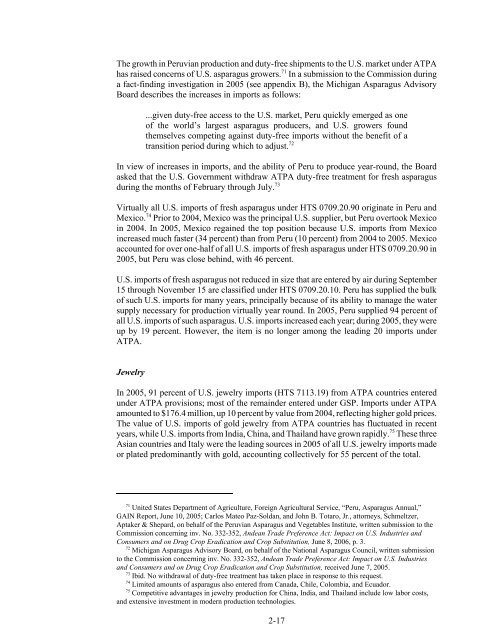The Impact of the Andean Trade Preference Act Twelfth ... - USITC
The Impact of the Andean Trade Preference Act Twelfth ... - USITC
The Impact of the Andean Trade Preference Act Twelfth ... - USITC
- No tags were found...
You also want an ePaper? Increase the reach of your titles
YUMPU automatically turns print PDFs into web optimized ePapers that Google loves.
<strong>The</strong> growth in Peruvian production and duty-free shipments to <strong>the</strong> U.S. market under ATPAhas raised concerns <strong>of</strong> U.S. asparagus growers. 71 In a submission to <strong>the</strong> Commission duringa fact-finding investigation in 2005 (see appendix B), <strong>the</strong> Michigan Asparagus AdvisoryBoard describes <strong>the</strong> increases in imports as follows:...given duty-free access to <strong>the</strong> U.S. market, Peru quickly emerged as one<strong>of</strong> <strong>the</strong> world’s largest asparagus producers, and U.S. growers found<strong>the</strong>mselves competing against duty-free imports without <strong>the</strong> benefit <strong>of</strong> atransition period during which to adjust. 72In view <strong>of</strong> increases in imports, and <strong>the</strong> ability <strong>of</strong> Peru to produce year-round, <strong>the</strong> Boardasked that <strong>the</strong> U.S. Government withdraw ATPA duty-free treatment for fresh asparagusduring <strong>the</strong> months <strong>of</strong> February through July. 73Virtually all U.S. imports <strong>of</strong> fresh asparagus under HTS 0709.20.90 originate in Peru andMexico. 74 Prior to 2004, Mexico was <strong>the</strong> principal U.S. supplier, but Peru overtook Mexicoin 2004. In 2005, Mexico regained <strong>the</strong> top position because U.S. imports from Mexicoincreased much faster (34 percent) than from Peru (10 percent) from 2004 to 2005. Mexicoaccounted for over one-half <strong>of</strong> all U.S. imports <strong>of</strong> fresh asparagus under HTS 0709.20.90 in2005, but Peru was close behind, with 46 percent.U.S. imports <strong>of</strong> fresh asparagus not reduced in size that are entered by air during September15 through November 15 are classified under HTS 0709.20.10. Peru has supplied <strong>the</strong> bulk<strong>of</strong> such U.S. imports for many years, principally because <strong>of</strong> its ability to manage <strong>the</strong> watersupply necessary for production virtually year round. In 2005, Peru supplied 94 percent <strong>of</strong>all U.S. imports <strong>of</strong> such asparagus. U.S. imports increased each year; during 2005, <strong>the</strong>y wereup by 19 percent. However, <strong>the</strong> item is no longer among <strong>the</strong> leading 20 imports underATPA.JewelryIn 2005, 91 percent <strong>of</strong> U.S. jewelry imports (HTS 7113.19) from ATPA countries enteredunder ATPA provisions; most <strong>of</strong> <strong>the</strong> remainder entered under GSP. Imports under ATPAamounted to $176.4 million, up 10 percent by value from 2004, reflecting higher gold prices.<strong>The</strong> value <strong>of</strong> U.S. imports <strong>of</strong> gold jewelry from ATPA countries has fluctuated in recentyears, while U.S. imports from India, China, and Thailand have grown rapidly. 75 <strong>The</strong>se threeAsian countries and Italy were <strong>the</strong> leading sources in 2005 <strong>of</strong> all U.S. jewelry imports madeor plated predominantly with gold, accounting collectively for 55 percent <strong>of</strong> <strong>the</strong> total.71United States Department <strong>of</strong> Agriculture, Foreign Agricultural Service, “Peru, Asparagus Annual,”GAIN Report, June 10, 2005; Carlos Mateo Paz-Soldan, and John B. Totaro, Jr., attorneys, Schmeltzer,Aptaker & Shepard, on behalf <strong>of</strong> <strong>the</strong> Peruvian Asparagus and Vegetables Institute, written submission to <strong>the</strong>Commission concerning inv. No. 332-352, <strong>Andean</strong> <strong>Trade</strong> <strong>Preference</strong> <strong>Act</strong>: <strong>Impact</strong> on U.S. Industries andConsumers and on Drug Crop Eradication and Crop Substitution, June 8, 2006, p. 3.72Michigan Asparagus Advisory Board, on behalf <strong>of</strong> <strong>the</strong> National Asparagus Council, written submissionto <strong>the</strong> Commission concerning inv. No. 332-352, <strong>Andean</strong> <strong>Trade</strong> <strong>Preference</strong> <strong>Act</strong>: <strong>Impact</strong> on U.S. Industriesand Consumers and on Drug Crop Eradication and Crop Substitution, received June 7, 2005.73Ibid. No withdrawal <strong>of</strong> duty-free treatment has taken place in response to this request.74Limited amounts <strong>of</strong> asparagus also entered from Canada, Chile, Colombia, and Ecuador.75 Competitive advantages in jewelry production for China, India, and Thailand include low labor costs,and extensive investment in modern production technologies.2-17
















